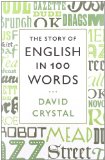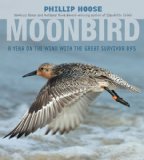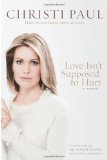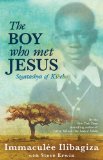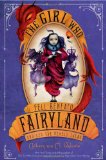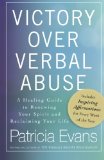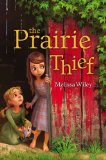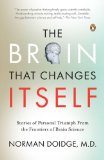 The Brain That Changes Itself
The Brain That Changes Itself
Stories of Personal Triumph from the Frontiers of Brain Science
by Norman Doidge, M.D.
Viking, 2007. 427 pages.
Starred Review
2012 Sonderbooks Stand-out: #6 Other Nonfiction
Big thanks to my friend and co-worker Ivelisse Figueroa-Gonzalez for recommending this book to me after I had my stroke.
This is a book about neuroplasticity. We have learned, fairly recently, that the brain can heal from injury; the brain can change its wiring. How we use our brains is important.
Some words from the Preface explain what you’ll find in this book:
This book is about the revolutionary discovery that the human brain can change itself, as told through the stories of the scientists, doctors, and patients who have together brought about these astonishing transformations. Without operations or medications, they have made use of the brain’s hitherto unknown ability to change. Some were patients who had what were thought to be incurable brain problems; others were people without specific problems who simply wanted to improve the functioning of their brains or preserve them as they aged. For four hundred years this venture would have been inconceivable because mainstream medicine and science believed that brain anatomy was fixed. The common wisdom was that after childhood the brain changed only when it began the long process of decline; that when brain cells failed to develop properly, or were injured, or died, they could not be replaced. Nor could the brain ever alter its structure and find a new way to function if part of it was damaged. The theory of the unchanging brain decreed that people who were born with brain or mental limitations, or who sustained brain damage, would be limited or damaged for life. Scientists who wondered if the healthy brain might be improved or preserved through activity or mental exercise were told not to waste their time. . . .
I began a series of travels, and in the process I met a band of brilliant scientists, at the frontiers of brain science, who had, in the late 1960s or early 1970s, made a series of unexpected discoveries. They showed that the brain changed its very structure with each different activity it performed, perfecting its circuits so it was better suited to the task at hand. If certain “parts” failed, then other parts could sometimes take over. The machine metaphor, of the brain as an organ with specialized parts, could not fully account for changes the scientists were seeing. They began to call this fundamental brain property “neuroplasticity.”
Neuro is for “neuron,” the nerve cells in our brains and nervous systems. Plastic is for “changeable, malleable, modifiable.” At first many of the scientists didn’t dare use the word “neuroplasticity” in their publications, and their peers belittled them for promoting a fanciful notion. Yet they persisted, slowly overturning the doctrine of the unchanging brain. They showed that children are not always stuck with the mental abilities they are born with; that the damaged brain can often reorganize itself so that when one part fails, another can often substitute; that if brain cells die, they can at times be replaced; that many “circuits” and even basic reflexes that we think are hardwired are not. One of these scientists even showed that thinking, learning, and acting can turn our genes on or off, thus shaping our brain anatomy and our behavior — surely one of the most extraordinary discoveries of the twentieth century.
In the course of my travels I met a scientist who enabled people who had been blind since birth to begin to see, another who enabled the deaf to hear; I spoke with people who had had strokes decades before and had been declared incurable, who were helped to recover with neuroplastic treatments; I met people whose learning disorders were cured and whose IQs were raised; I saw evidence that it is possible for eighty-year-olds to sharpen their memories to function the way they did when they were fifty-five. I saw people rewire their brains with their thoughts, to cure previously incurable obsessions and traumas. I spoke with Nobel laureates who were hotly debating how we must rethink our model of the brain now that we know it is ever changing.
The chapters of the book look at different aspects of neuroplasticity. He covers many different things, including stroke recovery; sharpening perception and memory; healing learning problems; stopping worries, obsessions, and bad habits; counteracting aging; psychoanalysis; and even sexual attraction and love.
I can’t emphasize enough how fascinating this book is. I’m not sure if it has direct application to my own stroke, since it hit my balance center, not my higher thinking. (Though I did purchase a balance board after reading this book.) I’ve already recommended the book to parents of children with OCD, and I’ve decided that my guilty pleasure of doing Killer Sudoku at bedtime is actually therapy so I won’t lose my ability to think logically as I age.
And so much of the book, whether practical or not, is simply interesting. Here’s an example:
When it came to allocating brain-processing power, brain maps were governed by competition for precious resources and the principle of use it or lose it.
The competitive nature of plasticity affects us all. There is an endless war of nerves going on inside each of our brains. If we stop exercising our mental skills, we do not just forget them: the brain map space for those skills is turned over to the skills we practice instead. If you ever ask yourself, “How often must I practice French, or guitar, or math to keep on top of it?” you are asking a question about competitive plasticity. You are asking how frequently you must practice an activity to make sure its brain map space is not lost to another.
Competitive plasticity in adults even explains some of our limitations. Think of the difficulty most adults have in learning a second language. The conventional view now is that the difficulty arises because the critical period for language learning has ended, leaving us with a brain too rigid to change its structure on a large scale. But the discovery of competitive plasticity suggests there is more to it. As we age, the more we use our native language, the more it comes to dominate our linguistic map space. Thus it is because our brain is plastic — and because plasticity is competitive — that it is so hard to learn a new language and end the tyranny of the mother tongue.
But why, if this is true, is it easier to learn a second language when we are young? Is there not competition then too? Not really. If two languages are learned at the same time, during the critical period, both get a foothold. Brain scans, says Merzenich, show that in a bilingual child all the sounds of its two languages share a single large map, a library of sounds from both languages.
Another fascinating section speculating about cognitive problems as we age:
Mezenich says, . . . “We have an intense period of learning in childhood. Every day is a day of new stuff. And then, in our early employment, we are intensely engaged in learning and acquiring new skills and abilities. And more and more as we progress in life we are operating as users of mastered skills and abilities.”
Psychologically, middle age is often an appealing time because, all else being equal, it can be a relatively placid period compared with what has come before. Our bodies aren’t changing as they did in adolescence; we’re more likely to have a solid sense of who we are and be skilled at a career. We still regard ourselves as active, but we have a tendency to deceive ourselves into thinking that we are learning as we were before. We rarely engage in tasks in which we must focus our attention as closely as we did when we were younger, trying to learn a new vocabulary or master new skills. Such activities as reading the newspaper, practicing a profession of many years, and speaking our own language are mostly the replay of mastered skills, not learning. By the time we hit our seventies, we may not have systematically engaged the systems in the brain that regulate plasticity for fifty years.
That’s why learning a new language in old age is so good for improving and maintaining the memory generally. Because it requires intense focus, studying a language turns on the control system for plasticity and keeps it in good shape for laying down sharp memories of all kinds. . . . Anything that requires highly focused attention will help that system — learning new physical activities that require concentration, solving challenging puzzles, or making a career change that requires that you master new skills and material. Merzenich himself is an advocate of learning a new language in old age. “You will gradually sharpen everything up again, and that will be very highly beneficial to you.”
The same applies to mobility. Just doing the dances you learned years ago won’t help your brain’s motor cortex to stay in shape. To keep the mind alive requires learning something truly new with intense focus. That is what will allow you to both lay down new memories and have a system that can easily access and preserve the older ones.
Another whole chapter deals with progress in healing stroke patients. I’m not yet sure how it applies to me, because the effects of my stroke were not immediately obvious. Now they are manifesting as vestibular migraines. Is it possible that working with the balance centers of my brain would begin to rewire my brain? This book raises intriguing questions in my mind as well as revealing lots of answers to questions I had never before asked.
Fascinating reading for anyone at all interested in the brain and how it works.
penguin.com
Buy from Amazon.com
Find this review on Sonderbooks at: www.sonderbooks.com/Nonfiction/brain_that_changes_itself.html
Disclosure: I am an Amazon Affiliate, and will earn a small percentage if you order a book on Amazon after clicking through from my site.
Source: This review is based on a library book from the Fairfax County Public Library.
Disclaimer: I am a professional librarian, but I write the posts for my website and blogs entirely on my own time. The views expressed are solely my own, and in no way represent the official views of my employer or of any committee or group of which I am part.
 I discovered Jasper Fforde in 2004, thanks to the recommendation of my friend Shannon. The first two books in the Thursday Next series were both 2004 Sonderbooks Stand-outs in Science Fiction and Fantasy, The Eyre Affair at #2, and Lost in a Good Book at #5.
I discovered Jasper Fforde in 2004, thanks to the recommendation of my friend Shannon. The first two books in the Thursday Next series were both 2004 Sonderbooks Stand-outs in Science Fiction and Fantasy, The Eyre Affair at #2, and Lost in a Good Book at #5. 2005 Sonderbooks Stand-outs. The third book, The Well of Lost Plots, was #4 in Science Fiction. The fourth book, Something Rotten, was #1 in Science Fiction.
2005 Sonderbooks Stand-outs. The third book, The Well of Lost Plots, was #4 in Science Fiction. The fourth book, Something Rotten, was #1 in Science Fiction.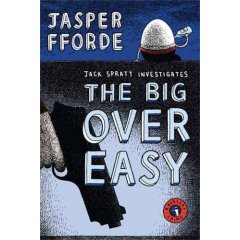 And then he started writing the Nursery Crime series. The Big Over Easy, solving the mystery of who pushed Humpty Dumpty, was also a 2005 Sonderbooks Stand-out, #7 in Mystery.
And then he started writing the Nursery Crime series. The Big Over Easy, solving the mystery of who pushed Humpty Dumpty, was also a 2005 Sonderbooks Stand-out, #7 in Mystery.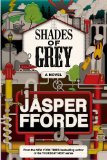 which was a 2010 Sonderbooks Stand-out. The whole society is based on what colors people can see. (How does he come up with these ideas, anyway?) Shades of Grey: The Road to High Saffron was #7 in Fiction for adults.
which was a 2010 Sonderbooks Stand-out. The whole society is based on what colors people can see. (How does he come up with these ideas, anyway?) Shades of Grey: The Road to High Saffron was #7 in Fiction for adults.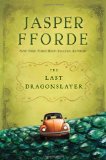 There you have it, 9 Sonderbooks Stand-outs, and I’ve only been reading his books since 2004. I highly recommend his books for any time you’re in the mood for clever, quirky, and bizarre. More bizarre than pretty much any other author you’d ever care to read. In a good way.
There you have it, 9 Sonderbooks Stand-outs, and I’ve only been reading his books since 2004. I highly recommend his books for any time you’re in the mood for clever, quirky, and bizarre. More bizarre than pretty much any other author you’d ever care to read. In a good way.